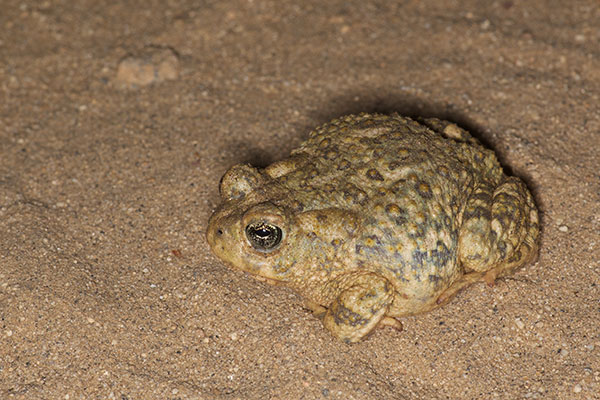Anaxyrus californicus
—
Arroyo Toad
The genus Anaxyrus was split from Bufo by Frost et al in 2006. This split is particularly controversial among herpetologists, and many references still use the long-established Bufo.

When we arrived at Mike's Sky Rancho at about dusk, no sign of human life was apparent, and we were initially worried that we'd have to keep driving (which would have been a disaster, due to the hellish condition of the "road" leading onward). But someone had in fact heard us approach, and they soon opened the front gate and invited us in. We were the only guests that evening, so they hadn't bothered to turn on the generator yet, but they did run it for our benefit for a couple of hours. The generator powered a couple of lights in the front parking area, which brought out a couple of toads who patiently awaited the nocturnal insect windfall that always accompanies electric lights in the wilderness.
I originally identified this toad as a Western Toad (Anaxyrus boreas), but a helpful naturalist at iNaturalist.org suggested that it looked like A. californicus. I did some further research on the differences in appearance of these two species and agreed. Evidence included:
- There's no dorsal stripe. Most descriptions of A. boreas mention the dorsal stripe as if it were always present, though I've heard that it is sometimes not visible.
- According to Grismer, "Bufo boreas from the Sierra Juárez and Sierra San Pedro Mártir and their eastern foothills have a pale, light green to dark brown ground color that contrasts vividly with the dark-colored dorsal blotches." I don't think that "vivid contrast" is evident in this toad.
- Arroyo Toads typically have the following light patches: a stripe on the top of the head from one eye to the other; the front part of the parotoid glands; on top of the sacral humps. I think faded versions of all of these are visible in this toad.
- Arroyo Toads are smaller than Western Toads, and the Mike's Sky Rancho toads were significantly smaller than full-size Western Toads. Of course, they might have both been juveniles. But if they were both adults than their size would be more Arroyo Toad-like.
Printed references:
- Elliott, L., Gerhardt, C. and Davidson, C. 2009. The Frogs and Toads of North America
- Grismer, L. L. 2002. Amphibians and Reptiles of Baja California Including its Pacific Islands and the Islands in the Sea of Cortés
- Lemm, J. M. 2006. Field Guide to Amphibians and Reptiles of the San Diego Region
- McPeak, R. H. 2000. Amphibians and Reptiles of Baja California
- Stebbins, R. C. 2003. Peterson Field Guide to Western Reptiles and Amphibians, Third Edition
- Stebbins, R. C. 1972. California Reptiles and Amphibians